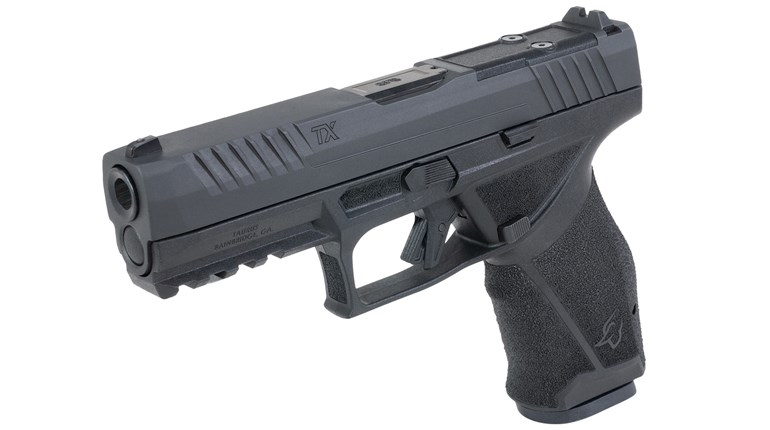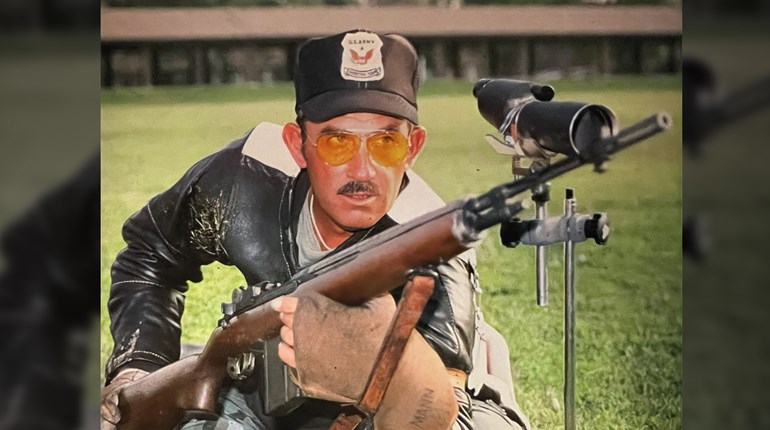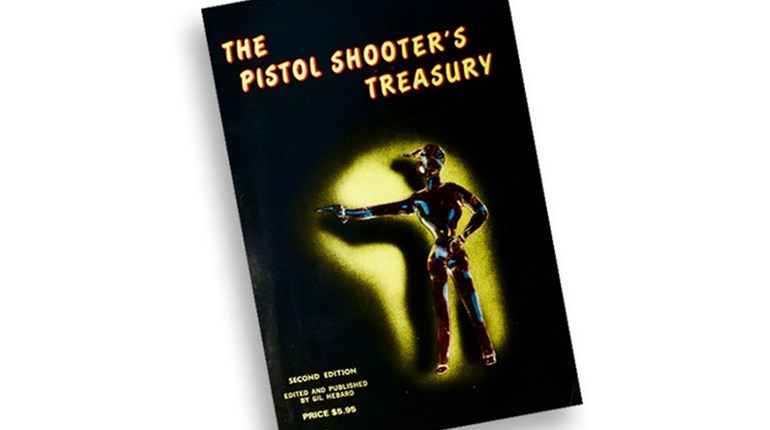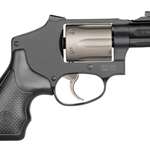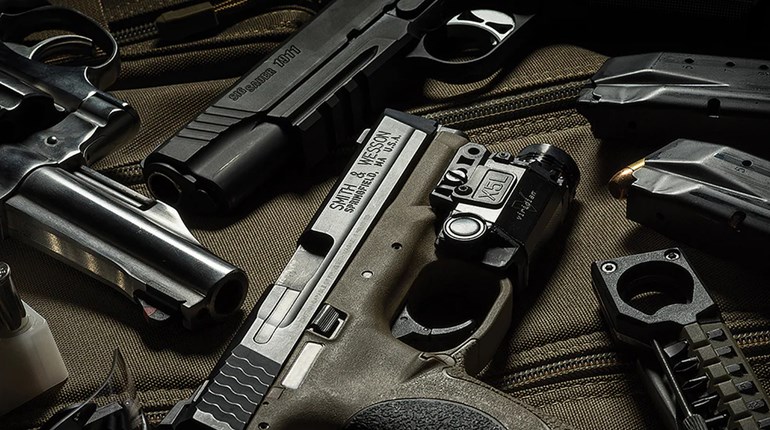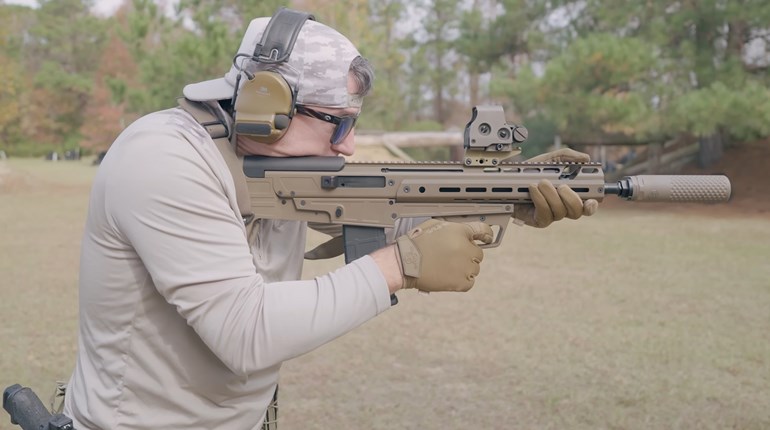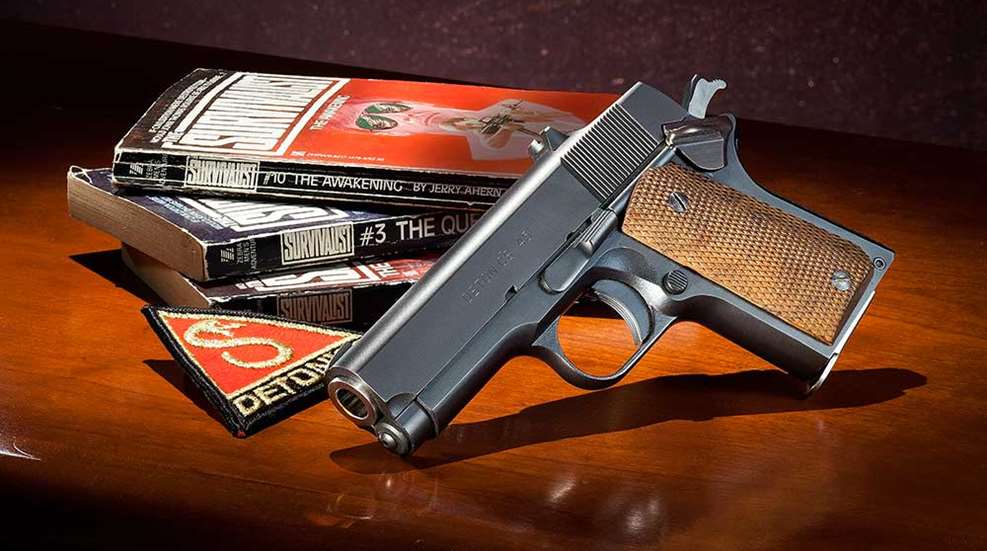
This article, "Detonics Combat Master," appeared originally as a Classics column in the August 2013 issue of Shooting Illustrated. To subscribe to the magazine, visit the NRA membership page here and select Shooting Illustrated as your member magazine.
There are classic firearms, and then there are cult-classic firearms—those that manage to garner a loyal following that supercedes their being overshadowed by more-prolific pistols. The Detonics Combat Master pistol fits into that category, which reflects its importance in the annals of firearms development during an era when semi-automatic handguns were decidedly not en vogue and a Colt Detective Special was the undercover cop’s sidearm of choice. That is, until the subcompact 1911 close in size of a conventional snub-nose changed the concept of big-bore, semi-automatic concealability.
It was during the early 1970s, when an engineer named Pat Yates, who worked for the Explosives Corporation of America (EXCOA), decided to see if he could make his own subcompact 1911. Co-worker and fellow firearms enthusiast Sid Woodcock liked the idea and offered to help. After building a few prototypes based on chopped-and-channeled Colt M1911A1s, they joined forces with two former EXCOA managers, Mike Maes and Chuck Lyford, who had formed an explosives company in Seattle, WA, aptly named Detonics.
The company envisioned a pistol capable of being mass-produced, yet still possessing the reliability of a custom-made handgun. Thus evolved the Detonics Combat Master: the world’s first commercially manufactured, subcompact, single-action semi-automatic. Measuring 6 3⁄4 inches long by 4 5⁄8 inches tall, it was not much larger than a Smith & Wesson J-frame—but chambered in the much larger .45 ACP.
While the Combat Master utilized many modified 1911 parts, other components, such as the trigger and slide stop, were completely interchangeable. Despite those similarities, however, it was more than the miniaturized 1911’s unique design that set it apart from its predecessor. The Combat Master didn’t require the added expense of a gunsmith for all the bells and whistles. It contained several unique features, which in addition to being cutting edge for the time, paved the way to popularize 1911 customization and led to many of the components found on today’s commercial and custom-built models.
Perhaps the most obvious of these concerned the absence of a grip safety and the sloping contour along the rear of its slide, which lessened the slide’s mass and sped up its shortened travel. The rear-sight assembly was moved forward, closer to the ejection port. Although this decreased the pistol’s already short sight radius, the Combat Master still proved accurate at close range.
To help achieve its compactness, the grip was shortened, resulting in a magazine capacity of only six rounds, although the pistol would accommodate a standard seven-round magazine sticking out slightly. Similar to G.I.-issue magazines, Combat Master offerings featured nonremovable, permanent floorplates that stopped short of meeting flush with the magazine’s spine, leaving a small notch. The use of a Devel-syle follower confirmed maximum capacity at a glance by protruding slightly from the floorplate when the magazine was full. This feature, in conjunction with witness holes, provided tactile and visual readiness confirmation.
The pistol’s feed ramp was polished and throated to accept hollow points, and the use of a self-adjusting, cone-shaped, barrel-centering system (another of the pistol’s innovative features) enhanced lockup by eliminating the need for a bushing. The barrel was a half inch shorter than that of the Colt Commander. As a further means of accommodating the abbreviated travel of the Combat Master’s slide and lessen battering during reciprocation, the pistol utilized dual, captive, counterwound, nested recoil springs (later models featured a three-spring system) complete with a guide rod and a reverse plug.
Grips were wood or Pachmayr rubber, and pistols were shipped with the same type and brand of mainspring housing. Initial models were offered in matte-blue finish, but the Combat Master line was eventually extended to include brushed-nickel , hard-chrome and polished-blue finishes. Hammers on initial offers contained a stubby, triangular-shaped spur to reduce bite.
Of the 17,000 guns produced between 1976 and 1987, many were returned due to feeding problems. Another problem with the Combat Master that was not so easily solved was its high cost of production, which translated into a price that was less than competitive. Still, the Combat Master had some notable admirers, including the late Col. Jeff Cooper, who wrote, “This remarkable pistol is the smallest, lowest-recoil single-action .45-caliber semi-automatic in the world... It is capable of providing the brute-force stopping power of the standard-sized .45 in a size no larger than a snub-nosed .38, or ‘pocket’ 9mm auto…This masterpiece of combat design is gaining recognition as the finest defensive handgun in the world today.”
But financial problems plagued Detonics, even when the line was increased by introducing the larger Servicemaster and Scoremaster. Finally, on April 29, 1986, the company filed for bankruptcy. Its assets were subsequently purchased by a group of investors, and Detonics moved to Phoenix, AZ, where it was renamed New Detonics. In spite of the relocation, it eventually closed in 1992.
Detonics remained dormant until 2004, when it was resurrected by the late gunwriter and novelist Jerry Ahern, who had written about the Combat Master from its inception in his popular 27-book series of novels entitled “The Survivalist.” Its main character, Dr. John Rourke, was armed with a pair of Combat Master .45s in the books’ post-apocalyptic setting. Ahern renamed the company Detonics USA and moved it to Pendergrass, GA. During his tenure, the Streetmaster, featuring a full-size slide on a Combat Master frame, and the Model 9-11-01 were added to the product line.
Ahern’s official involvement with the Combat Master lasted until November, 2007, when Detonics USA was purchased by its present owners, Bruce Siddle and Dr. Steve Stahle, who changed the name back to Detonics, and relocated to Millstadt, IL. The company struggled to survive and, as of 2017, was no longer in business.
Although other models were made by Detonics, the Combat Master continues to inspire shooters, because as Ahern once wrote, “A weapon of which I am extremely fond is my Detonics Black Combat Master .45…the gun I carry virtually every day…Some things—guns, knives and other inanimate objects—just seem to fit one’s hand and one’s lifestyle so well, they become indispensable.”













